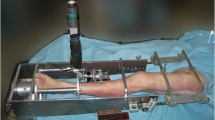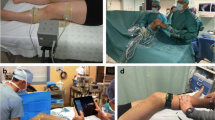Abstract
Traumatic rupture of the anterior cruciate ligament (ACL) of the knee is one of the most frequent orthopaedic sports' injuries. However, the best operative reconstruction technique is still the focus of current discussions among experts. While single-bundle reconstruction primarily addresses anterior-posterior instability, the anatomical double-bundle reconstruction aims to stabilise anterior-posterior as well as rotational instability. So far no definite evidence to favour the one or the other technique exists due to the lack of an objective method for quantifying rotational knee stability. In this context several authors have recently reported on devices for the analysis of femorotibial rotation. However, most of these tools are still in the developmental stage. Therefore, the aim of this study was (1) to develop a new instrument for assessing rotational knee stability independent from the surrounding soft tissue with an adequate method of analysis and (2) to establish the possible field of application of this device in a human cadaver study. The so-called torsiometer evaluated was designed to assess internal and external knee joint rotation objectively in different flexion angles. Measurements were performed implying internal and external rotation at 90°, 30° and 0° knee flexion with and without intact ACL, respectively. Each measurement revealed valid and reproducible values. The restraint in ACL-absent knees was clearly lower and the course of rotation explicitly higher than in knee joints with intact ACL.




Similar content being viewed by others
References
Gianotti SM, Marshall SW, Hume PA, Bunt L (2009) Incidence of anterior cruciate ligament injury and other knee ligament injuries: a national population-based study. J Sci Med Sport 12:622–627.
Parkkari J, Pasanen K, Mattila VM, Kannus P, Rimpelä A (2008) The risk for a cruciate ligament injury of the knee in adolescents and young adults: a population-based cohort study of 46 500 people with a 9 year follow-up. Br J Sports Med 42(6):422–426. doi:10.1136/bjsm.2008.046185
Petersen W, Zantop T (2007) Anatomy of the anterior cruciate ligament with regard to its two bundles. Clin Orthop Relat Res 454:35–47. doi:10.1097/BLO.0b013e31802b4a59
Zantop T, Herbort M, Raschke MJ, Fu FH, Petersen W (2007) The role of the anteromedial and posterolateral bundles of the anterior cruciate ligament in anterior tibial translation and internal rotation. Am J Sports Med 35(2):223–227. doi:10.1177/0363546506294571
Zantop T, Petersen W, Sekiya JK, Musahl V, Fu FH (2006) Anterior cruciate ligament anatomy and function relating to anatomical reconstruction. Knee Surg Sports Traumatol Arthrosc 14(10):982–992. doi:10.1007/s00167-006-0076-z
Zelle BA, Vidal AF, Brucker PU, Fu FH (2007) Double-bundle reconstruction of the anterior cruciate ligament: anatomic and biomechanical rationale. J Am Acad Orthop Surg 15(2):87–96.
Franceschi JP, Sbihi A, Champsaur P (2002) Arthroscopic reconstruction of the anterior cruciate ligament using double anteromedial and posterolateral bundles (in French). Rev Chir Orthop Reparatrice Appar Mot 88(7):691–697.
Meredick RB, Vance KJ, Appleby D, Lubowitz JH (2008) Outcome of single-bundle versus double-bundle reconstruction of the anterior cruciate ligament: a meta-analysis. Am J Sports Med 36(7):1414–1421. doi:10.1177/0363546508317964
Gadikota HR, Seon JK, Kozanek M, Oh LS, Gill TJ, Montgomery KD, Li G (2009) Biomechanical comparison of single-tunnel-double-bundle and single-bundle anterior cruciate ligament reconstructions. Am J Sports Med 37(5):962–969. doi:10.1177/0363546508330145
Araki D, Kuroda R, Kubo S, Fujita N, Tei K, Nishimoto K, Hoshino Y, Matsushita T, Matsumoto T, Nagamune K, Kurosaka M (2010) A prospective randomised study of anatomical single-bundle versus double-bundle anterior cruciate ligament reconstruction: quantitative evaluation using an electromagnetic measurement system. Int Orthop. doi:10.1007/s00264-010-1110-9
Prins M (2006) The Lachman test is the most sensitive and the pivot shift the most specific test for the diagnosis of ACL rupture. Aust J Physiother 52(1):66
Benjaminse A, Gokeler A, van der Schans CP (2006) Clinical diagnosis of an anterior cruciate ligament rupture: a meta-analysis. J Orthop Sports Phys Ther 36(5):267–288
Anderson AF, Rennirt GW, Standeffer WC Jr (2000) Clinical analysis of the pivot shift tests: description of the pivot drawer test. Am J Knee Surg 13(1):19–23, discussion 23–24
Galway HR, MacIntosh DL (1980) The lateral pivot shift: a symptom and sign of anterior cruciate ligament insufficiency. Clin Orthop Relat Res 147:45–50
Sadoghi P, Müller PE, Jansson V, van Griensven M, Kröpfl A, Fischmeister MF (2010) Reconstruction of the anterior cruciate ligament: a clinical comparison of bone-patellar tendon-bone single bundle versus semitendinosus and gracilis double bundle technique. Int Orthop. doi:10.1007/s00264-010-1037-1
Almquist PO, Arnbjörnsson A, Zätterström R, Ryd L, Ekdahl C, Fridén T (2002) Evaluation of an external device measuring knee joint rotation: an in vivo study with simultaneous Roentgen stereometric analysis. J Orthop Res 20(3):427–432. doi:10.1016/S0736-0266(01)00148-6
Lorbach O, Wilmes P, Maas S, Zerbe T, Busch L, Kohn D, Seil R (2009) A non-invasive device to objectively measure tibial rotation: verification of the device. Knee Surg Sports Traumatol Arthrosc 17:756–762. doi:10.1007/s00167-009-0756-6
Tsai AG, Musahl V, Steckel H, Bell KM, Zantop T, Irrgang JJ, Fu FH (2008) Rotational knee laxity: reliability of a simple measurement device in vivo. BMC Musculoskelet Disord 9:35. doi:10.1186/1471-2474-9-35
Seon JK, Park SJ, Lee KB, Yoon TR, Seo HY, Song EK (2009) Stability comparison of anterior cruciate ligament between double- and single-bundle reconstructions. Int Orthop 33(2):425–429. doi:10.1007/s00264-008-0530-2
Papachristou G, Kalliakmanis A, Papachristou K, Magnissalis E, Sourlas J, Plessas S (2008) Comparison of fixation methods of double-bundle double-tibial tunnel ACL reconstruction and double-bundle single-tunnel technique. Int Orthop 32(4):483–488. doi:10.1007/s00264-007-0343-8
Kim SJ, Kim HK (1995) Reliability of the anterior drawer test, the pivot shift test, and the Lachman test. Clin Orthop Relat Res 317:237–242
Jardin C, Chantelot C, Migaud H, Gougeon F, Debroucker MJ, Duquennoy A (1999) Reliability of the KT-1000 arthrometer in measuring anterior laxity of the knee: comparative analysis with Telos of 48 reconstructions of the anterior cruciate ligament and intra- and interobserver reproducibility (in French). Rev Chir Orthop Reparatrice Appar Mot 85(7):698–707.
Kasović M, Mejovšek M, Matković B, Janković S, Tudor A (2010) Electromyographic analysis of the knee using fixed-activation threshold after anterior cruciate ligament reconstruction. Int Orthop. doi:10.1007/s00264-010-1050-4
Kubo S, Muratsu H, Yoshiya S, Mizuno K, Kurosaka M (2007) Reliability and usefulness of a new in vivo measurement system of the pivot shift. Clin Orthop Relat Res 454:54–58. doi:10.1097/BLO.0b013e31802b4a38
Georgoulis AD, Papadonikolakis A, Papageorgiou CD, Mitsou A, Stergiou N (2003) Three-dimensional tibiofemoral kinematics of the anterior cruciate ligament-deficient and reconstructed knee during walking. Am J Sports Med 31(1):75–79
Pearle AD, Solomon DJ, Wanich T, Moreau-Gaudry A, Granchi CC, Wickiewicz TL, Warren RF (2007) Reliability of navigated knee stability examination: a cadaveric evaluation. Am J Sports Med 35(8):1315–1320. doi:10.1177/0363546507300821
Georgoulis AD, Ristanis S, Chouliaras V, Moraiti C, Stergiou N (2007) Tibial rotation is not restored after ACL reconstruction with a hamstring graft. Clin Orthop Relat Res 454:89–94. doi:10.1097/BLO.0b013e31802b4a0a
Colombet P, Robinson J, Christel P, Franceschi JP, Djian P (2007) Using navigation to measure rotation kinematics during ACL reconstruction. Clin Orthop Relat Res 454:59–65. doi:10.1097/BLO.0b013e31802baf56
Kanamori A, Zeminski J, Rudy TW, Li G, Fu FH, Woo SL (2002) The effect of axial tibial torque on the function of the anterior cruciate ligament: a biomechanical study of a simulated pivot shift test. Arthroscopy 18(4):394–398.
Acknowledgements
This study has been supported by a grant from the Deutsche Arthrose-Hilfe e.V. (Frankfurt am Main, Germany).
Conflict of interest
The authors declare that they have no conflict of interest.
Author information
Authors and Affiliations
Corresponding author
Rights and permissions
About this article
Cite this article
Ahrens, P., Kirchhoff, C., Fischer, F. et al. A novel tool for objective assessment of femorotibial rotation: a cadaver study. International Orthopaedics (SICOT) 35, 1611–1620 (2011). https://doi.org/10.1007/s00264-010-1159-5
Received:
Revised:
Accepted:
Published:
Issue Date:
DOI: https://doi.org/10.1007/s00264-010-1159-5




